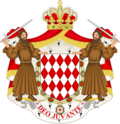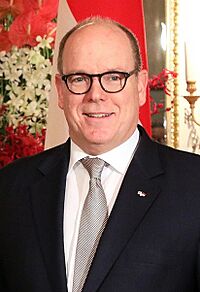Monarchy of Monaco facts for kids
Quick facts for kids Sovereign Prince of Monaco |
|
|---|---|

Arms of His Highness the Sovereign Prince of Monaco
|
|
| Incumbent | |
 |
|
| Albert II since 6 April 2005 |
|
| Details | |
| Style | His Serene Highness |
| Heir apparent | Jacques |
| First monarch | Honoré II (as prince; previous rulers were called lords until 1612) |
| Formation | 29 November 1604 |
| Residence | Prince's Palace |
| Website | Monarchy of Monaco |
The sovereign prince of Monaco (French: prince de Monaco) is the monarch and head of state of the Principality of Monaco. This means the prince is the ruler and main leader of the country. All reigning princes and princesses have been part of the House of Grimaldi. This family has ruled Monaco for over 800 years, making them Europe's longest-ruling royal family!
Prince Rainier III was the longest-reigning monarch in Europe when he passed away in 2005. The current reigning prince is Albert II. He became prince in April 2005.
Contents
What Powers Does the Prince Have?
Monaco is one of only three countries in Western Europe where the ruler still plays a big part in daily government. The other two are Liechtenstein and Vatican City.
How the Prince Governs Monaco
The Prince of Monaco uses his power according to the country's Constitution and its laws. He is in charge of Monaco's relationships with other countries. If the Constitution needs to be changed, the prince and the National Council must both agree.
Who Makes the Laws?
Making laws in Monaco is a shared job. The Prince suggests new laws, and the National Council votes on them. However, the prince has the final say. He can stop any law proposed by the National Council if he doesn't agree with it.
Who Runs the Government?
The prince also holds the power to run the government. The main government officials, like the minister of state and the Government Council, report directly to the prince. They are responsible to him for how the country is managed.
The Prince and Justice
The prince also has power over the courts and justice system. The Constitution says that the prince has full authority in the courts. Justice is carried out in his name.
Awards and Honors from the Prince
The prince can give out special awards, orders, and titles. This is because he is considered the fons honorum (source of honor) for Monaco. You can learn more about these awards in the Awards and decorations of Monaco article.
People in Monaco are very loyal to their princely family. In 2005, The New York Times reported that most residents would not say anything negative about the monarchy.
How is the Princely Family Paid?
The royal family gets money each year from Monaco's budget. In 2015, this amount was €43.5 million.
What are the Prince's Titles?
The Prince of Monaco is officially called His Serene Highness. He also has many other old titles that he inherited. Some of these titles are sometimes given to his family members.
Understanding the Prince's Many Titles
These titles came from the Grimaldi family gaining control of different lands over time. Today, these titles do not mean the prince owns or rules those lands. However, the princes of Monaco have long owned a lot of land and castles in France.
Many of these titles were given or recognized by the Kingdom of France or the Papal States. They could only be passed down through the male family line. Because of this, many of these French titles ended when Prince Louis II died in 1949. After that, some of these titles were created again as special Monegasque titles.
Some of the Prince's Main Titles:
- Sovereign Prince of Monaco
- Duke of Valentinois
- Duke of Estouteville
- Duke of Mazarin
- Duke of Mayenne
- Prince of Château-Porcien
- Marquis of Baux (This title is now used by Hereditary Prince Jacques)
- Count of Polignac (This title is now used by Princess Stéphanie)
- Count of Carladès (This title is now used by Princess Gabriella)
- Baron of Massy (This title is now used by Christian Louis de Massy, son of Princess Antoinette)
When people write official letters to the prince, they always capitalize words like "His" or "He" when referring to him.
The Flag and the Prince's Location
Traditionally, a flag would fly from the tower above the prince's office only when he was in Monaco. However, the current prince flies the flag all the time. He prefers to keep his exact location private.
Monaco is officially protected by France. This agreement was made in the Treaty of Versailles in 1919.
See also
 In Spanish: Príncipe de Mónaco para niños
In Spanish: Príncipe de Mónaco para niños
- List of Monégasque consorts
- List of rulers of Monaco
- Succession to the Monegasque throne

